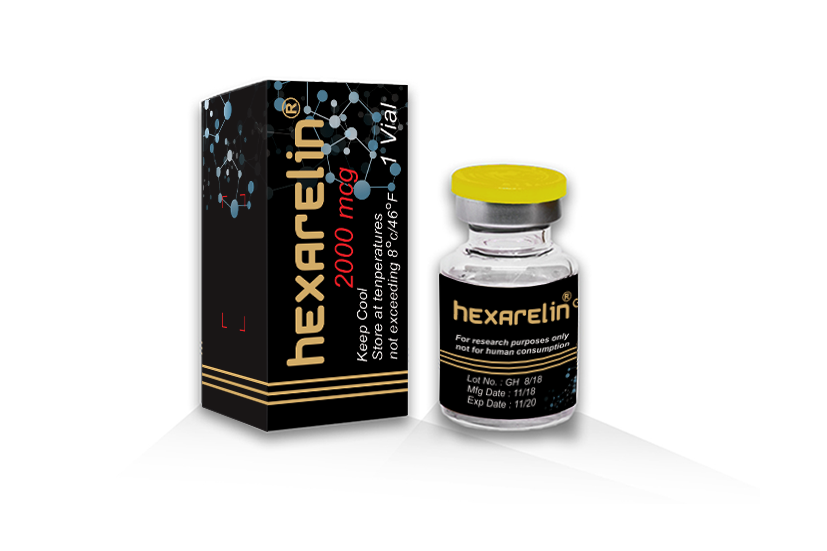Hexarelin
All the information below is strictly for research purposes only. Under no circumstance should this chemical be used for human consumption.
Peptide purity: > 99.0%
Chain: D-Ala-D-β-Nal-Ala-Trp-D-Phe-Lys-NH2
Formula: C50H69N15O9
Molecular weight: 1024.2
CAS: 121062-08-6
Hexarelin is peptide containing 6 amino acid very similar to GHRP-6. The compound works by acting on the hypothalamus and pituitary gland to stimulate gH secretion.
Hexarelin has a molecular weight of 887.04 and molecular formula C47H58N12O6. Along with the stimulation of glands to release more gH production it may also play a role in the protection and healing process for cardiac problems and possess some neuroprotective functions. Continued research is focusing on Hexarelin’s affect on the brain and on its potential at protecting CNS after injuries. Hexarelin is still being studied and its total influence still under testing, this peptide is manufactured for research only.
Hexarelin (HEXA) is a peptide GH secretagogue with a potent ability to stimulate GH secretion and recently reported cardioprotective actions. Because Hexarelin’s amino acid sequence may help in promoting the body to produce more Growth Hormone, it will not shut down the body’s own production.Hexarelin is a synthetic peptide composed of 6 amino acids making it a hexaptide with a structure that has been considered to promote the release of Growth Hormone. Effects from GH include increased bone mineral density, increased mitosis and meiosis which leads to more muscle mass, triglyceride hydrolysis which causes prominent fat loss, connective tissue strengthening, and improved skin elasticity. Because Hexarelin’s amino acid sequence may help in promoting the body to produce more Growth Hormone, it will not shut down the body’s own production. This is a very important factor and makes Hexarelin an attractive chain when compared to Growth Hormone alone.
Hexarelin is a non-natural (synthetic) growth hormone (GH)-releasing hexapeptide which belongs to the GHS family. This particular protein has been found to act on both pituitary gland and the hypothalamus, however, its mechanisms of action in the human physiologic system has not yet been fully elucidated (Arvat et al. 1995). This synthetic peptide has similar GH-secreting properties with its predecessors such as the GHRP-6, GHRP-2 and GHRP-1. Hexarelin is GHRP analog in which the Trp was substituted with chemically more table 2-Methyl-Trp (Denghenghi et al. 1994). The chemical structure of which is shown in the following: Many studies on mice have been carried out geared towards deeper understanding of its chemical activity. Many studies reported that some of its effects are increase in muscle strength and endurance, gain muscle mass, neural protection, rehabilitation of the joints and increased rate of wound healing. However, unlike GHRP-6, hexarelin does not induce food intake because of its incapability to drastically increase the grehlin levels that are responsible for the feeling of hunger and faster emptying of the gastric system. But the studies of Deghenghi et al. (1994) reported that hexarelin possessed similar effectiveness in stimulating the GH release in a long-lasting event and slightly more effective than the GHRP-6. These are supported by a number of studies. Locatelli et al. (1999) reported that hexarelin provides protection and healing especially for the cardiac dysfunction and abnormalities. They have observed that 7 days after the administration of the hexarelin to the rat, it prevented the exacerbation of the ischemia-reperfusion damage that has been induced by hypophysectomy. Furthermore, hexarelin also prevented the increase in diastolic pressure of the left ventricular end, so as with coronary perfusion pressure, reactivity of the coronary vasculature to angiotensin and release of the creatine kinase from the perfusate of the heart. Also, it was suggested that hexarelin prevented the fall in prostacyclin release and enhances recovery of contractility. It has also been noted that its mechanisms of action are not mediated by the growth hormone, but most probably because of the activation of specific receptors in the heart (Locatelli et al. 1999). The same results had been obtained by the investigations of Ghigo et al. (1994) whioch have shown that hexarelin administered through the intravenous route had limited variability, but had been suggested to be dose-dependent. It can then be used and administered to humans for clinical applications. Hexarelin (HEXA) is a peptide GH secretagogue with a potent ability to stimulate GH secretion and recently reported cardioprotective actions.
Chemical and other safety information:
|
H-statements (GHS/CLP): |
P-statements (GHS/CLP): |
|---|---|
|
H302: Harmful if swallowed. |
P102: Keep out of reach of children. |
|
H315: Causes skin irritation |
P232: Protect from moisture. |
|
H319: Causes serious eye irritation. |
P235: Keep cool. |
|
H332: Harmful if inhaled. |
P261: Avoid breathing dust/fume/gas/mist/vapours/spray. |
|
P264: Wash hands thoroughly after handling. |
|
|
P301+P312: IF SWALLOWED: Call a POISON CENTER or doctor/physician if you feel unwell. |
|
|
P302+P352: IF ON SKIN: Wash with plenty of soap and water. |
|
|
P301+P330+P331: IF SWALLOWED: rinse mouth. Do NOT induce vomiting. |
|
|
P332+313: If skin irritation occurs: Get medical advice/attention. |
|
|
P411+235: Store at temperatures not exceeding 8°C/46°F. Keep cool |
The latter article is intended for educational / informational purposes only. THIS PRODUCT IS INTENDED AS A RESEARCH PEPTIDE ONLY. This designation allows the use of research peptides strictly for in vitro testing and laboratory experimentation only. Bodily introduction of any kind into humans or animals is strictly forbidden by law.

